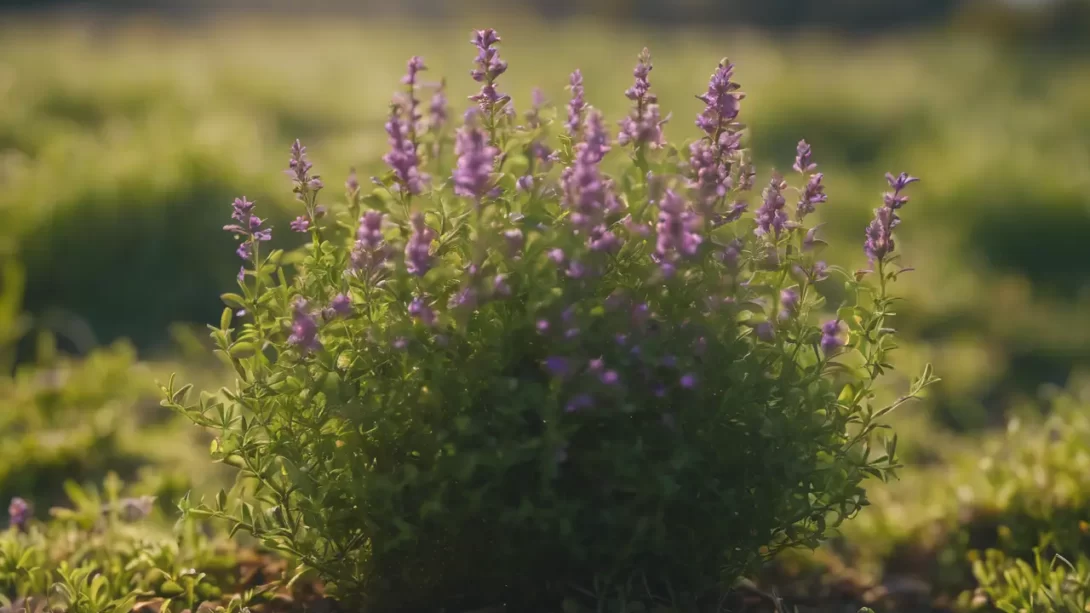Creeping thyme (Thymus serpyllum), a popular choice for gardeners, is renowned for its aromatic foliage and vibrant flowers. This low-growing perennial is often used as a ground cover, offering an attractive alternative to traditional lawns. A crucial question for many gardeners is whether creeping thyme can coexist with grass or if it poses a threat to overtaking lawns. This article delves into the dynamics between creeping thyme and grass, providing insights for those considering integrating this herb into their garden.
Creeping Thyme
Creeping thyme is a versatile and hardy plant, thriving in a variety of conditions. It is characterized by its small, fragrant leaves and a tendency to spread across the ground, forming a dense mat. This plant favors well-drained soil and full to partial sun exposure. Creeping thyme blooms in summer, displaying a range of colors from white to pink and purple. Gardeners often choose creeping thyme for its low maintenance, drought tolerance, and ability to suppress weeds, making it an excellent ground cover option.
Characteristics of Grass in Gardens
In contrast to creeping thyme, lawn grasses come in many varieties, each with unique characteristics. Common types include fescue, Bermuda, and Kentucky bluegrass. These grasses vary in their texture, color, and growth habits. Grass generally requires more maintenance than creeping thyme, including regular mowing, watering, and fertilizing. It thrives best in well-drained, fertile soil and needs ample sunlight to maintain its vigor and density. Understanding these differences is key to determining how creeping thyme and grass might interact in a garden setting.
Interaction Between Creeping Thyme and Grass
Creeping thyme spreads primarily through its stems, which root at nodes and expand outward, forming a dense carpet-like layer. This growth habit allows it to cover ground quickly and efficiently. When creeping thyme is introduced into a lawn, it can start to fill in gaps within the grass, especially in areas where the grass is sparse or weak. While creeping thyme is not inherently aggressive towards grass, its ability to thrive in less-than-ideal conditions can give it an advantage, potentially leading to it overshadowing the grass over time.
Factors Influencing the Growth of Creeping Thyme vs Grass
The balance between creeping thyme and grass in a garden is influenced by several key factors:
Soil Conditions
Creeping thyme prefers well-drained, slightly sandy soil and can tolerate poor nutrient conditions better than many grass species. If the soil in a garden is particularly suited to creeping thyme, it may gain an upper hand over grass.
Light Requirements
Both creeping thyme and grass need sunlight, but creeping thyme can tolerate partial shade better than most grasses. In areas with less sunlight, creeping thyme might outperform grass.
Watering Needs
Creeping thyme has low water requirements and is drought-resistant, unlike many types of grass that require consistent moisture. In drier conditions, creeping thyme will likely thrive while grass may struggle.
Maintenance
Regular mowing benefits grass by keeping it dense and healthy, which can help it compete with creeping thyme. Neglecting lawn maintenance can give creeping thyme an opportunity to become more established.
Case Studies and Research Findings
Various studies and anecdotal evidence provide insights into the relationship between creeping thyme and grass. Some landscapers have observed that creeping thyme can coexist with grass, forming an intermingled ground cover that requires less mowing and maintenance. However, other cases show creeping thyme gradually dominating over grass, especially in conditions favorable to the herb. These observations suggest that the outcome is highly dependent on specific garden conditions and care practices.
Managing Creeping Thyme in a Lawn Setting
To successfully incorporate creeping thyme into a lawn without it overpowering the grass, consider the following strategies:
- Planting Techniques: Plant creeping thyme around the edges of your lawn or in specific sections where grass struggles to grow. This approach allows for a natural, complementary coexistence.
- Regular Maintenance: Maintain your lawn’s health through regular mowing, watering, and fertilizing. A healthy, dense lawn can more effectively compete with creeping thyme.
- Monitoring and Control: Keep an eye on the spread of creeping thyme. If it begins encroaching too much into the grass, trim it back or remove sections to maintain balance.
Alternative Ground Covers
If you are concerned about creeping thyme potentially overtaking your lawn, consider other ground cover options:
- Clover (Trifolium spp.): This plant can coexist with grass, enriching the soil with nitrogen.
- Perennial Peanut (Arachis glabrata): A low-growing, drought-resistant plant that can blend well with grass.
- Moss: Ideal for shady, moist areas where grass struggles to grow.
Each of these alternatives offers unique benefits and may be better suited for specific garden environments or aesthetic preferences.
Frequently Asked Questions
Q: Will creeping thyme survive regular lawn mowing? A: Creeping thyme can tolerate light mowing, but excessive mowing may damage the plant over time.
Q: Can creeping thyme be used as a sole lawn alternative? A: Yes, creeping thyme can be used to create a full ground cover, ideal for low-foot-traffic areas.
Q: Is creeping thyme pet-friendly? A: Yes, creeping thyme is generally safe for pets and can withstand light foot traffic.
Conclusion
Creeping thyme can be a wonderful addition to gardens, offering a fragrant, low-maintenance ground cover. However, its ability to coexist with grass depends on various factors, including soil quality, light availability, watering practices, and maintenance. By understanding and managing these factors, gardeners can enjoy the benefits of both creeping thyme and a lush lawn. Ultimately, the decision to integrate creeping thyme into your garden should be informed by your specific garden conditions and your overall landscaping goals.




